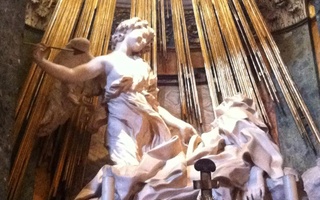As you enter the most recent wing of the Fogg Art Museum, you will be struck by the first exhibit on display: the bust of Saint Jerome, the third century Italian translator of the Bible into the Latin Vulgate. Stained with the terrible anguish that comes with the recognition of the sin of intellectual pride, Saint Jerome's eyes are closed, yet you can tell that they are full of the sorrow and contrition that only a sincerely devout human being can experience. Browsing through the corpulent volume entitled "Bernini" that is conveniently provided at the front of the exhibit, you will observe that the completed marble version of the clay impression has Jerome rest his head upon a cross, oblivious to the rest of the world in his religious penitence, that is more than touching--it is heartrending in its faith.
Anyone familiar with the Ecstasy of Saint Teresa will know that Gian Lorenzo Bernini, the greatest sculptor of the Roman Baroque, had to have been a deeply religious man. Nothing less than divine inspiration could have enabled him to create the works stamped with his trademark devotion--the extraordinarily vivid angels, seemingly descended directly from heaven in a swirl of fluid drapery, are instilled with awe and holy adoration that transcend the earthly constraints of clay.
The inauguration of the exhibit Gian Lorenzo Bernini: Sketches in Clay, in a permanent collection gallery of the Fogg Art Museum celebrates the quartercentenary of Bernini's birth. The works on display are studies for some of Bernini's most important projects, including the design for the sculptural decoration for the Ponte Sant' Angelo, the Tiber River bridge for pilgrims approaching St. Peter's Basilica and the architectural and sculptural setting for the Ecstasy of Saint Teresa.
In 1667, Pope Clement IX Rospigliosi commissioned Bernini to work on the Ponte Sant' Angelo project. For the next two years, the sculptor cast his ideas into clay, creating models for 10 over life-size marble angels, each carrying an instrument of Christ's Passion. Of the 10 angels, eight were carved by sculptors under Bernini's direction, and Bernini's own work was confined to the angels holding the Crown of Thorns and the Superscription. When the Pope visited Bernini's studio, he was so impressed with Bernini's two angels that he declared them too beautiful for outdoor display. He commissioned two replacements in their stead, and Bernini's marble angels remained in the sculptor's house until 1729, when his son presented them to the nearby Church Sant' Andrea delle Fratte.
Five of the clay sketches in the Fogg installation are studies by Bernini for the Ponte Sant' Angelo and offer a unique opportunity to follow the artist's creative ideas. The centerpieces of the collection are the sketches of the angels holding the Superscription and the Scourge, which the artist modified to study the fall of drapery. A generous furling of the angel's robe over her left leg adds a touch of breathtaking reality to the sculpture, making it seem as though the seraph was caught in a rush of hallowed breath. The angels' expressions of mute adoration and longing, suffusing their day faces with the worship of the divine, are even more striking than the extraordinary fluidity of their raiment.
In symmetrical antithesis to the Angel Holding the Superscription is the Angel Holding the Crown of Thorns. Though Bernini himself sketched the clay ideas for several of the angels that now adorn the Ponte Sant' Angelo, the marble statues themselves were carved under his direction by his pupil Lazzaro Morelli. Another of the clay sketches for the Tiber River bridge project, the Angel Holding the Tabernacle is an exquisite metaphor in terracotta for the power of divine influence.
The sketch of Saint Longinus, also on display, is the only intact surviving model of 22 sketches for the giant marble figure of the centurion who pierced Christ's side, only to then discover His divinity. Longinus is one of four figures planned for the altar niches at the crossing of St. Peter's Basilica. The bronze cast of the As a perfect compliment to the great master'sgenius, an appropriate citation from Hesiod's"Works and Days" was emblazoned on the glowinggreen walls that surrounded the exhibit: "And Zeus ordered famous Hephaistos to mix; asswiftly as possible, earth with water, and to putinto it the voice and strength of humankind." Gian Lorenzo Bernini succeeded in employingclay to manifest not only the voice and strengthof humankind, but also the voice of somethinginfinitely greater, something that subdues thevoice of humankind into accepting its humblenature, something ineffable in its divinity
Read more in Arts
The Coen Brothers' Loopy Lebowski Is Rife With Memorable CharactersRecommended Articles
-
SPORTSAll right, so we jumped the gun a little. Last week this column predicted the imminent demise of the Free-World-leading
-
Film Politicsfancy opticals (an idea handled infinitely better, by the way, in Peter Whitehead's Tonight Let's All Make Love in London
-
Games Scheduled in Scrub SeriesTwo games will be played this afternoon in scrub hockey which will bring the series down to the finals in
-
Tickets to Six Forster Forums Will Be FreeFree tickets for the series of six Kirkland House Forums on E. M. Forster may be obtained at Warren House
-
 Reconciliation
Reconciliation













